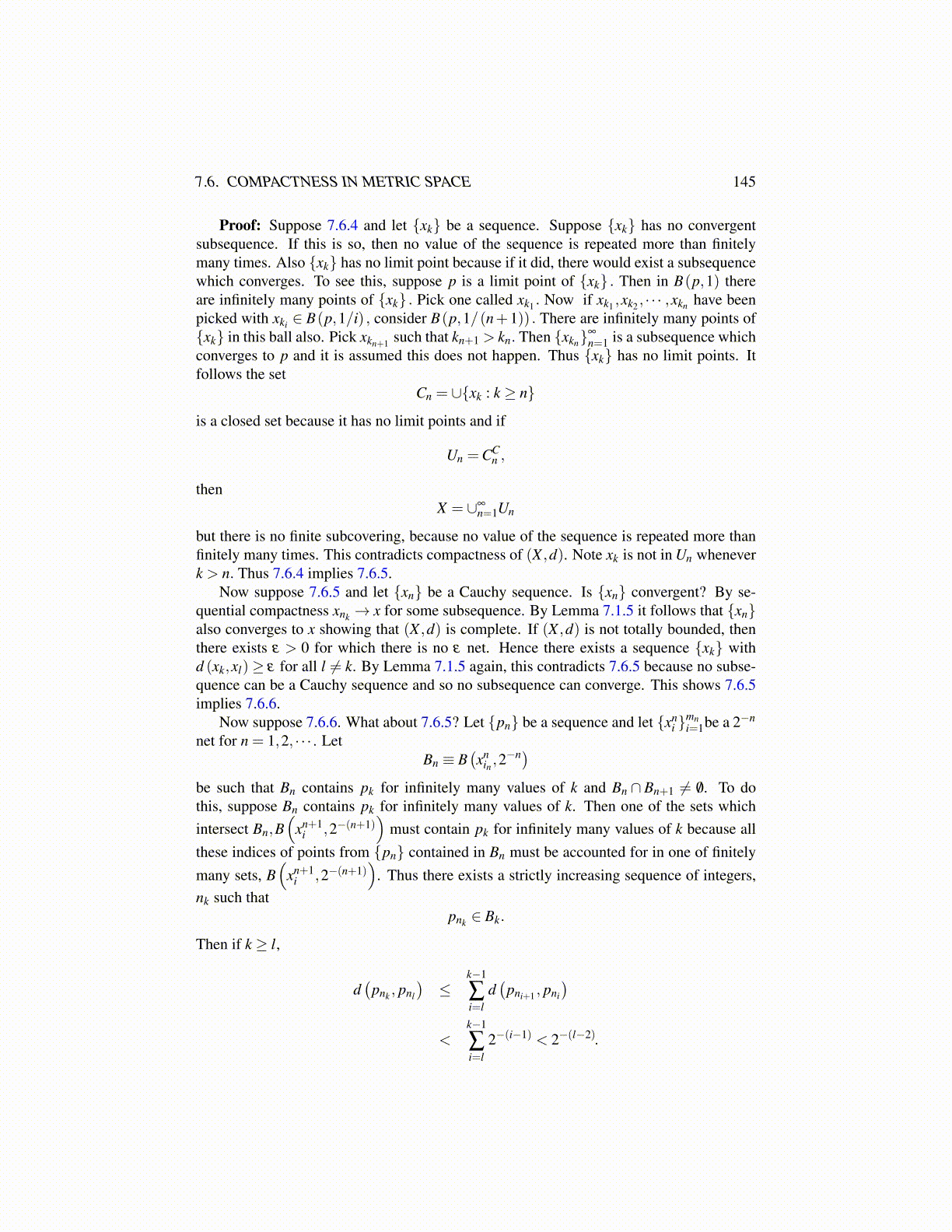
7.6. COMPACTNESS IN METRIC SPACE 145
Proof: Suppose 7.6.4 and let {xk} be a sequence. Suppose {xk} has no convergentsubsequence. If this is so, then no value of the sequence is repeated more than finitelymany times. Also {xk} has no limit point because if it did, there would exist a subsequencewhich converges. To see this, suppose p is a limit point of {xk} . Then in B(p,1) thereare infinitely many points of {xk} . Pick one called xk1 . Now if xk1 ,xk2 , · · · ,xkn have beenpicked with xki ∈ B(p,1/i) , consider B(p,1/(n+1)) . There are infinitely many points of{xk} in this ball also. Pick xkn+1 such that kn+1 > kn. Then {xkn}
∞
n=1 is a subsequence whichconverges to p and it is assumed this does not happen. Thus {xk} has no limit points. Itfollows the set
Cn = ∪{xk : k ≥ n}
is a closed set because it has no limit points and if
Un =CCn ,
thenX = ∪∞
n=1Un
but there is no finite subcovering, because no value of the sequence is repeated more thanfinitely many times. This contradicts compactness of (X ,d). Note xk is not in Un wheneverk > n. Thus 7.6.4 implies 7.6.5.
Now suppose 7.6.5 and let {xn} be a Cauchy sequence. Is {xn} convergent? By se-quential compactness xnk → x for some subsequence. By Lemma 7.1.5 it follows that {xn}also converges to x showing that (X ,d) is complete. If (X ,d) is not totally bounded, thenthere exists ε > 0 for which there is no ε net. Hence there exists a sequence {xk} withd (xk,xl)≥ ε for all l ̸= k. By Lemma 7.1.5 again, this contradicts 7.6.5 because no subse-quence can be a Cauchy sequence and so no subsequence can converge. This shows 7.6.5implies 7.6.6.
Now suppose 7.6.6. What about 7.6.5? Let {pn} be a sequence and let {xni }
mni=1be a 2−n
net for n = 1,2, · · · . LetBn ≡ B
(xn
in ,2−n)
be such that Bn contains pk for infinitely many values of k and Bn ∩ Bn+1 ̸= /0. To dothis, suppose Bn contains pk for infinitely many values of k. Then one of the sets whichintersect Bn,B
(xn+1
i ,2−(n+1))
must contain pk for infinitely many values of k because allthese indices of points from {pn} contained in Bn must be accounted for in one of finitelymany sets, B
(xn+1
i ,2−(n+1))
. Thus there exists a strictly increasing sequence of integers,nk such that
pnk ∈ Bk.
Then if k ≥ l,
d(
pnk , pnl
)≤
k−1
∑i=l
d(
pni+1 , pni
)<
k−1
∑i=l
2−(i−1) < 2−(l−2).